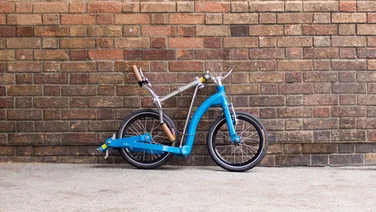To help us provide you with free impartial advice, we may earn a commission if you buy through links on our site. Learn more










- Wide, grippy deck
- Dual braking from a single brake lever
- Rear brake is electronic
- Folding clip not secure enough
- Stem is slightly flexible
The Indi-EX2 e-scooter is a Halfords exclusive and its among the cheapest electric scooters you can buy. It has an unusual look to it, but theres plenty of substance to its performance beneath the glitz, and it comes with the post-purchase support that buying from a major retailer gains you.
Indi EX-2 review: What do you get for the money?
Aside from the low price of £389, its the Neo-Chrome finish of Indi EX-2s frame that really catches the eye. Its iridescent colouring looks great, and the broad, shaped plywood-and-griptape deck tops it off nicely, lending it a look thats more reminiscent of a traditional human-powered scooter or skateboard than the homogenous blocky, boring look of most rivals. Its also available in black, but why opt for that when this model looks so great?
The Indi EX-2 is as practical as it is attractive. That deck is nice and wide at 19cm and its long, too, at 40cm, making it easy to find a comfortable riding position. Although the plywood material means it isnt as robust as scooters with metal and rubber platforms, its worth noting that the deck easily unscrews for replacement so any accidental damage shouldnt be a big issue.










The rest of the scooters configuration is much more standard. Underneath the deck is a 280Wh battery, which delivers a claimed maximum range of 18 miles exactly what youd expect of a budget e-scooter and the motor is a basic 350W unit built into the rear wheel. Stopping is taken care of by a front drum brake with cable adjustment and a rear electronic brake, both neatly controlled from the same single brake lever. All cable runs are nicely integrated into the frame tubing or hidden away neatly.










The scooters folding stem drops down, securing onto the rear mudguard, making an easily transportable package of 44 x 108 x 47.5cm (WDH). The handlebars dont fold or unscrew, making it a bit more unwieldy in its folded state than many rivals. However, on the plus side, it is very light at 14.7kg.
The real downside in terms of portability is that the handlebar catch uses the sprung rear mudguard to hold it in place and, if youre not careful, this can be knocked out and the package can unfold unexpectedly. Thats not a huge deal if youre aware of it, but a more secure catch design would definitely be preferable.
There are other elements of the design that Im not too keen on as well. The folding hinge, for instance, is secure enough but theres a little flex in the steering post once its locked in place. Allied with the rider weight rating of 100kg, this means its perhaps a model more for smaller, lighter riders and for leisure use. Heavier users who are looking for a daily commuter might want to look elsewhere: for example, the sturdy TurboAnt X7 Pro (£463).










Another signal that the Indi EX-2 is intended for a lighter workload is that it has 8.5in pneumatic tyres front and rear instead of the larger 10in were increasingly seeing on pricer models. These dont have any mitigation against punctures, either, which is a tad disappointing when other models ship with puncture-resistant or non-pneumatic puncture-proof wheels.
READ NEXT: Our full roundup of the best electric scooters
Indi EX-2 review: How does it ride?
Despite the relatively small 8.5in tyres, comfort is a major plus point on the Indi EX-2. That lovely wide standing area certainly helps, but I found the 8.5in tyres rolled well, even on bumpier surfaces such as moderately potholed roads, as long as I dropped my speed and put my weight back on the scooter.










The scooters large central LCD display is readable even in bright sunlight, and shows your speed up to the maximum 15mph assist limit, which the Indi EX-2 attains pretty rapidly on a flat, smooth surface. There are three riding modes 6mph, 10mph and 15mph and I toggled straight up to the max for our range testing. Once youve got used to the way an e-scooter feels to ride, this is the mode youll likely use most of the time.
I achieved a range of 10 miles on my newly designed test course; while this doesnt sound a lot compared to the typical range of 13 miles and the maximum of 18 miles claimed by Indi, I should point out my test course is quite hilly and involves a couple of lengthy, smooth off-road sections. With that in mind, I can see a lighter rider achieving 18 miles on a decent tarmac surface with not too many hills, as long as they drop down to lower speeds when conditions dictate.










Hill climbing is on a par with most other budget e-scooters Ive tried: it has good speed up very moderate hills, slower rates on steeper ones and comes to a halt on demanding gradients. In other words, its hill climbing ability is entirely par for the course and certainly not as bad as some e-scooters Ive tried.
When it is moving, the tyres feel safe and grippy, probably thanks to their nice wide profile, and the dual braking system is sharp but effective. The electronic rear brake doesnt have a great deal of modulation it feels either on or off but the front drum brake gives plenty of control; the key is gentle use of the lever.
The LED lights are fairly budget models but the front one is adequate for riding on unlit roads and paths.
Indi EX-2 review: Should you buy one?
If price is important in your search for an e-scooter then the Indi EX-2 is a definite contender. Indeed, if you prefer to buy in-store instead of online, then theres not an awful lot of competition for it at all.
My only real wishlist additions would be a stronger steering stem, which puts it out of contention for larger riders looking for a scooter they can use for regular, long-distance commuting.
Otherwise, the Indi EX-2 is a decent all-rounder with a comfortable ride and excellent braking. Its certainly one to put on the budget e-scooter hunters list.
E-scooter use in the UK
Despite the fact that they’re now a common sight in UK cities, you should be aware that private electric scooters are currently classified as personal light electric vehicles in the UK, which means that youre only legally allowed to use them on private land with the landowners permission. If youre caught riding one on roads or pavements, you could be fined and receive six points on your driving licence. This may soon change, however, with the UK government setting out plans to expand the legal use of e-scooters in the Queens Speech on 10 May 2022. The only way you can currently ride an e-scooter legally in the UK is to rent one via one of the legal pilot schemes operating in some cities.






